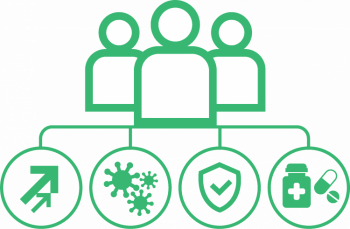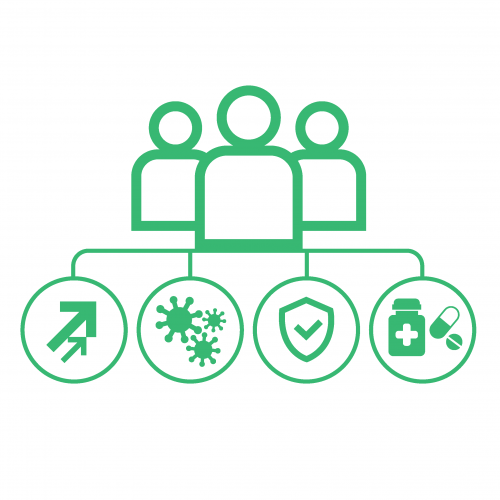
1. Specialty drugs will account for 50% of drug spending in 2018
Recently, CVS Caremark predicted that specialty drugs will account for 50% of drug spending in 2018, up from 30% in 2012.1 This explosion in revenue is due to a continued decline in revenue generated from blockbuster primary care products and from a ramp up in launches of specialty products. In fact, half of the new chemical entities approved in 2016 were considered specialty products.2 Further, seven new biologics and 17 specialty drugs received new indications creating a significant and growing revenue stream. These new products are different from primary care products, demanding different go-to-market models with different platforms and supporting organizational structures.
Specialty products, which we’ll define here as high-cost complex treatments for chronic conditions with special handling instructions,3 have become a focus area for many organizations that previously managed large primary care portfolios. For example, Merck, Bristol-Myers Squibb, and AstraZeneca have invested heavily in growing immuno-oncology portfolios while other large pharmaceutical companies have entered the specialty marketplace in other therapeutic areas; examples of these expansions include NUCALA (GSK; severe asthma), DUPIXENT (Sanofi/Regeneron, atopic dermatitis), and LARTRUVO (Eli Lilly, Soft Tissue Sarcoma).4 This migration from primary to specialty care has forced organizations to think differently about how they go-to-market, which has impacted the people they hire, the processes they use to engage with customers and the tools that support those customer-facing roles.
In both primary care and specialty care models, the main goal of a sales representative is to have a health care provider (HCP) prescribe your product to the appropriate patient. This is done by clearly establishing in the HCP’s mind that:
Establishing these facts in the mind of the HCP requires long term, repeat and “just in time” engagement to ensure that your product is top of mind when the HCP is confronted with a patient who has the condition your product addresses. In the primary care setting where an HCP might see multiple patients a week with a specific condition, a sales representative can thrive in a small territory where (s)he visits an HCP with regularity (i.e., weekly, bi-weekly, or monthly). With the high frequency of engagement, the sales representative can build personal relationships with HCPs, understand and, more importantly remember, the HCPs’ drivers for decision making, and then act on her extensive personal knowledge to drive action. In this scenario, data is critical to establish a Call Plan that complies with government licensing and HCP/institutional preferences. However, once the Call Plan is defined, the value of the data about the HCP become less critical to day-to-day interactions of the representative.
2. Successful specialty pharma execution
By contrast, in the specialty care setting, HCPs may only see one or two patients a year with a condition. In this scenario, a frequency model is incredibly expensive and destroys the profit margin for the product. To be efficient, the organization must decrease the number of sales representatives, decrease the frequency of sales calls to an HCP, and expand the size of the territory a single representative covers. Further, specialty practices often limit the number of times a pharmaceutical company – including reps, Medical Science Liaisons, and other customer-facing roles – can visit with an HCP annually. In this model, data becomes much more critical to successful specialty pharma execution in three ways:
Call-routing software can leverage available data to identify when a sales representative needs to show up in an HCP’s office. These tools leverage blinded patient claims data related to diagnostic tests, ICD-10 codes selected during a routine visit or a set of symptoms to identify when a patient may have a specific condition or, if the condition is already being treated, be ready to progress to their next treatment. Armed with the data from these tools, sales representatives can arrive “just in time” to ensure the HCP has the relevant information to make an informed prescribing decision. In a recent McKinsey & Co. insight, the authors suggested an example of early signals for disease progression where “patients suffering from the genetic disorder Gaucher disease might experience fatigue, a distended abdomen, low appetite, bruising, and stunted growth, and hence have accumulated claims codes for splenomegaly, hepatomegaly, anemia, or thrombocytopenia”6. Leveraging data analytics platforms such as Shyft’s Analytics Cloud, organizations can develop algorithms to surface these patients and help direct representatives to connect with the right HCP at the right time.
Sales representative may only see a customer a few times a year so the need for pre-call planning becomes more important. Data empowers improved pre-call planning by helping to build on previous interactions from both a relationship and educational perspective. Whether identifying important influencers in the office, capturing the HCP decision-making processes, discussion topics from previous visits, or keeping track of office follow-ups, the need to capture this information in a central repository is critical: unlike frequency-based primary care models, representatives can’t be expected to remember HCP specific information between visits.
Due to the limited HCP interactions and larger territories, there is a high potential for significant travel time and increased expense in specialty. Moreover, the need to deliver the right message at the right time to the right audience requires coordination between many different company roles. While boundaries must exist for sharing certain information between roles, knowing when customer-facing individuals, such as Medical Science Liaisons, Nurse Educators, Diagnostic Representatives, Customer Service Representatives, Sales Representatives, or Market Access team members last connected with a customer is critical. Carefully coordinating each customer interaction is essential to maximize efficiency of the organization and create a positive customer experience.
In addition to the ways in which sales representatives interact with HCPs and their office staff, the switch from primary to specialty care also impacts the types of roles that interact with an office, specifically from an access and affordability perspective. Access and affordability are highly important in the primary care setting but often receive limited coverage in a sales conversation for two reasons:
Pharmacy Benefit Managers (PBMs) and group purchasing organizations (GPOs) can contract with manufacturers to define tiers of access for products. These tiers establish clear prescribing direction for the HCP and allow the HCP and his or her staff to focus on affordability, which is often managed through commonly used tools such as free trial offers and savings card programs. Because most HCP offices are familiar with how these instruments work, sales representatives can deliver these as part of a “total office call”, thus reducing the need for additional “affordability” experts interacting with the office. However, in the case of specialty medication, volume often limits PBMs, GPOs and other groups from pre-determining access for patients. In addition to cost challenges that HCP offices must address in procuring the product (which we won’t discuss here), the approval process for a patient toreceive medication can be slow and tedious. A 2009 study based on a survey from more than 800 HCPs and staff estimated that prior authorizations alone consume 20 hours per week of HCP and office staff time 5 .In addition to costing HCP offices time and money, the prior authorization process can prevent a patient from receiving needed medication for days or weeks.
To address this process, pharmaceutical companies have developed payment/reimbursement managers and programs that can work with the patient, HCP, and insurance company. These programs are designed to reduce the burden on the HCP’s office while also getting the patient the medication (s)he needs quickly and without the worry of getting a big bill down the road. Like sales representatives, these resources are limited in number, so it is crucial to leverage data and technology to identify when the payment/reimbursement manager should engage with a specific office. This can be delivered through the same combination of passive triggers Sales Representatives use to visit an HCP’s office plus standardized task creation within the payment/reimbursement manager’s Customer Relationship Management (CRM) system.
3. Recommended approach
While pharmaceutical organizations recognize that the people and the process for customer engagement are different between primary and specialty care, all too often they attempt to retrofit existing platforms to meet the new needs. Even though most organizations would want to make the most of existing technology, if the systems are not set up for the way business is done in the specialty market (which as we’ve shown is quite different), it can put the organization at a significant disadvantage vis-à-vis its competitors.
“ To address these challenges, Vynamic recommends organizations strongly consider the benefits of building a parallel commercial operations approach (inclusive of operating model, processes, data and software) for their specialty products”.
The ability to build a fit-for-purpose technology platform as the backbone of the specialty practice will enable the organization to start with clean data for the sales representatives that need it and create efficient operating models that align to the different sales processes between specialty and primary care. Once the data model has been constructed, new instances of existing tools, with features configured to support the specialty process, could be leveraged to surface relevant information back to customer-facing resources to ensure they are maximizing the efficiency of their interactions.
Inherent in this recommendation is that we view primary and specialty care as different business units. We recognize the need to drive efficiency in primary care models, where the combination of fewer “blockbuster” drugs and increased pricing pressures are decreasing profits; but we also recognize that specialty is a growth business and as such, organizations must invest and focus on flexibility as customer engagement models continue to evolve. While this model will result in both additional up front and increased operational costs to support two platforms, we believe the long-term gains from improved customer interaction and more efficient operation will outweigh the investments.

Diplomat Clinical Services. “Specialty Drug Approvals: 2016 Highlights & 2017 Projections.” Accessed July 27, 2017
2CVS Health. “Specialty Pipeline: Blockbusters on the Horizon.” Insights Executive Briefing. Issue 5, 2016. Accessed June 27, 2017
3Tharaldson, Aimee, PharmD. “Specialty Pipeline Highlights”. Pharmacy Times. September 23, 2016. Accessed June 25, 2017
4Casalino, Lawrence P.; Nicholson, Sean; Gans, David N.; Hammons, Terry; Morra, Dante; Karrison, Theodore; Levinson, Wendy. “What Does It Cost Physician Practices To Interact With Health Insurance Plans?” Health Affairs. July/August 2009 28:4w533-w543; published ahead of print May 14, 2009. Accessed June 27, 2017
5Ascher, Jan; M’lika, Arafat; Graf, Jeff; Prabhakaran, Maha. “How to Successfully Launch a Rare Disease Drug in a Patient-Centric World.” McKinsey & Co. Article January 2017. Accessed June 20, 2017
Vynamic, an Inizio Advisory company, is a leading management consulting partner to global health organizations across Life Sciences, Health Services, and Health Technology. Founded and headquartered in Philadelphia, Vynamic has offices in Boston, Durham NC, New York, and London. Our purpose is simple: We believe there is a better way. We are passionate about shaping the future of health, and for more than 20 years we’ve helped clients transform by connecting strategy to action.
Through a structured, yet flexible delivery model, our accomplished leaders work as an extension of client teams, enabling growth, performance, and culture. Vynamic has been recognized by organizations like Great Place to Work and Business Culture Awards for being leaders and innovators in consulting, company culture, and health. Visit Vynamic.com to discover how we can help transform your
organization or your career.
 Colleen Lawlor
Colleen Lawlor
Bring clarity to complexity and ensure a successful Alliance Launch with a cohesive culture, streamlined processes, and efficient asset management.
Read more Tamaron Bertelli
Tamaron Bertelli
This structured approach guides Med Affairs leaders in executing micro-transformations to drive meaningful impact for your organization and patients.
Read more Jess Werle
Jess Werle
Embrace MedTech's future by blending field and digital strategies to boost sales effectiveness, unleash the power of data, and stand out in the market
Read more